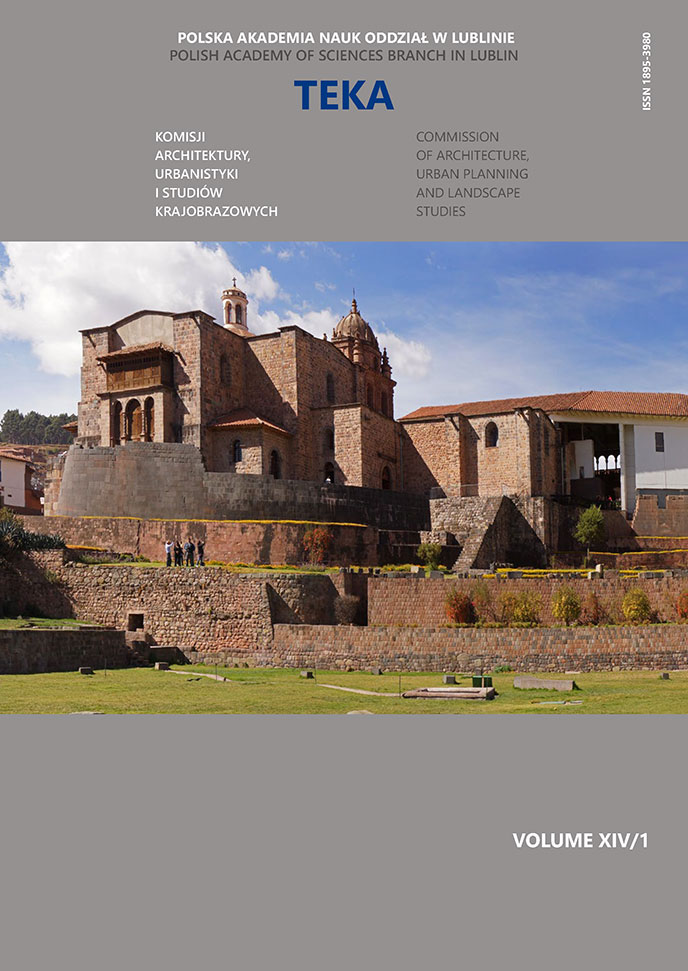Lighting policy as an integral part of sustainable urban planning
Article Sidebar
Open full text
Issue Vol. 14 No. 1 (2018)
-
Astronomical observations in the Inca Temple of Coricancha (Cusco)? A critical review of the hypothesis
Mariusz Ziółkowski, Jacek Kościuk7-33
-
Lighting policy as an integral part of sustainable urban planning
Agata Łopuszyńska, Magdalena Belof34-43
-
Optical properties of opaque and light-transmitting photovoltaic systems in architecture and their influence on architectural form
Marcin Brzezicki, Magdalena Muszyńska-Łanowy44-54
-
Built environment of the tall housing buildings in Poland
Dariusz Gawel55-62
-
Features of housing sanation in the historical architectural environment
Kateryna Danko, Kashchenko Tetyana63-70
-
Hypothetic Reconstruction of The Development of The Defensive Structures of The Middle Town of Rohatyn in 15th−17th Centuries
Mykola Bevz71-88
-
The modernization of public spaces in problematic residential areas exemplified on selected projects and realizations in the Bronowice district of Lublin
Kamila Boguszewska, Natalia Przesmycka89-97
-
Project of revitalisation of the area next to the Potocki family Palace in Lublin
Patryk Krupiński, Krystyna Pudelska98-106
-
Classroom training strategies to strengthen the hotbed of research in architecture
Rolando Arturo Cubillos González107-115
-
Effect of accessibility in housing complexes on shaping of beauty in the urban environment. Selected examples from Cracow
Karolina Dudzic-Gyurkovich116-125
-
Architecture in transition: the case study of the dormition catedral in Volodymyr Volynskyi
Petro Rychkov126-135
-
The earliest public green areas connected with Jelenia Góra, part. 1.
Marzanna Jagiełło, Wojciech Brzezowski136-144
-
Overview and classification of housing forms intended for older and disable people occurring in high developed countries in context to deficit of similar forms in Poland
Monika Magdziak145-155
Archives
-
Vol. 16 No. 4
2020-12-30 11
-
Vol. 16 No. 3
2020-09-30 10
-
Vol. 16 No. 2
2020-06-30 11
-
Vol. 16 No. 1
2020-03-31 10
-
Vol. 15 No. 4
2019-12-30 6
-
Vol. 15 No. 3
2019-10-31 9
-
Vol. 15 No. 2
2019-06-28 12
-
Vol. 15 No. 1
2019-03-29 13
-
Vol. 14 No. 3
2018-10-28 14
-
Vol. 14 No. 2
2018-06-29 14
-
Vol. 14 No. 1
2018-03-30 13
-
Vol. 13 No. 4
2017-12-29 8
-
Vol. 13 No. 3
2017-09-29 9
-
Vol. 13 No. 2
2017-06-30 10
-
Vol. 13 No. 1
2017-03-31 10
-
Vol. 12 No. 4
2016-12-30 12
-
Vol. 12 No. 3
2016-09-30 10
-
Vol. 12 No. 2
2016-06-30 9
-
Vol. 12 No. 1
2016-03-31 8
Main Article Content
DOI
Authors
Abstract
The aim of the paper is to describe an evolution of approaches to regulation of artificial light in urban areas and present examples of existing practices in this regard. The authors introduce the theoretical debate on the lighting pollution phenomenon and outline the contemporary arguments for lighting planning as an element of broader urban policy. Presented examples of comprehensive approaches to urban light planning have been based on the results of international inquiry curried out in 2018.
Keywords:
References
Bogard P., 2013: The End of Night: Searching for Natural Darkness in an Age of Artificial Light. Hachette UK.
Brandi U., Geissmar-Brandi C., 2007: Light for cities. Lighting design for Urban Spaces. A Handbook. Birkhauser, Basel, Switzerland. DOI: https://doi.org/10.1007/978-3-7643-8263-6
CCLT, 2017: Collier County Lighting Standards. County-Wide Lighting Team. Collier County, Florida.
CIE, 2017: Guide on the Limitation of the Effects of Obtrusive Light from Outdoor Lighting Installations, 2nd Edition. Publication no. 150, Vienna, Austria. DOI: https://doi.org/10.25039/TR.150.2017
DW, 2017: LED-technology increases light pollution across the night sky. Deutsche Welle. https://p.dw.com/p/2o7jA (21.08.2018).
Ederson T., 2015: The gloomy city. Rethinking the relationship between light and dark. Urban Stud. 52(3), 422−438 DOI: https://doi.org/10.1177/0042098013504009
Holker F. et al., 2010: Light pollution as a biodiversity threat. Trends Ecol. Evol. 25(12), 681−682. DOI: https://doi.org/10.1016/j.tree.2010.09.007
IAU, 2009: Resolution B5 in Defence of the night sky and the right to starlight. XXVIIth General Assembly, Rio de Janeiro, Brazil.
IDA, 2010: Visibility, Environmental and Astronomical Issues Associated with Blue-Rich White Outdoor Lighting. International Dark-Sky Association, Tucson-Washington.
IDA 2011, Light Pollution Wastes Energy and Money. http://darksky.org/light-pollution/energy-waste/ (21.08.2018).
IDA-IES, 2011: Joint IDA-IES Model Outdoor Lighting Ordinance (MLO) with user’s guide. International Dark-Sky Association/Illuminating Engineering Society
ILP, 2011: Guidance notes for the reduction of obtrusive light. Publication no. GN 01. Institution of Lighting Professionals.
Kołomański S., 2015. Zanieczyszczenie światłem i ciemność. Prace i Studia Geograficzne 53, 29−46. DOI: https://doi.org/10.31338/uw.9788323514138.pp.29-46
Kyba Ch.C.M. et al., 2017: Artificially lit surface of Earth at night increasing in radiance and extent. Sci. Adv. 3(11). DOI: https://doi.org/10.1126/sciadv.1701528
Martyniuk-Pęczek J., 2014: Światła miasta. Marina, Wrocław.
Mohar A., 2018: Causes of light pollution. Managing security, ignorance, profit, corruption. LightPoll 2018, The First Vobanista Workshop on Light Pollution. Fruska Gora, 26.05.2018, Serbia.
Nawalkowski P., 2013: Problem zagrożenia światłem. Dzikie życie. 11(233), 11−13.
NCC, 2017: Capital Illumination Plan 2017−2027. National Capital Commission. Ottawa, Canada.
RASC 2016: Guidelines for Outdoor Lighting in Urban Star Parks (RASC-USP-GOL). Royal Astronomical Society of Canada Dark Sky Preserve Program. .
Rozwadowski T., 2007: Time sprawl: czy zagraża nam urbanizacja nocy? Urbanista. 5(53), 27−29
Ściężor T. et al., 2010: Zanieczyszczenie świetlne nocnego nieba w obszarze aglomeracji krakowskiej: analiza pomiarów sztucznej poświaty niebieskiej. Wyd. Polit. Krak. Kraków.
Stevens R.G., Zhu Y., 2015: Electric light, particularly at night, disrupts human circadian rhythmicity: is that a problem?.” Phil. Trans. R. Soc. B 370.1667 (2015): 20140120. DOI: https://doi.org/10.1098/rstb.2014.0120
Article Details
Abstract views: 304


